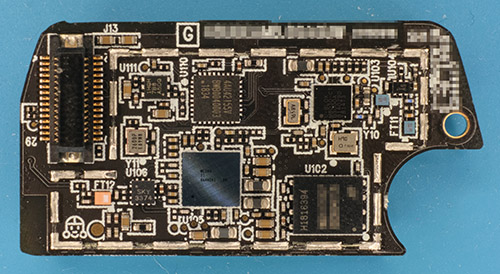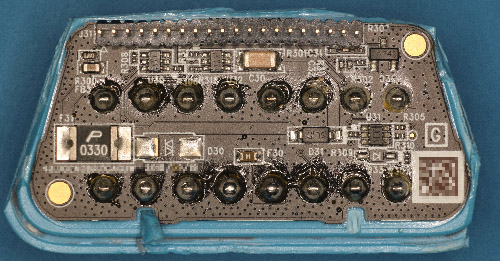The Ware for May 2023 is shown below.

This is yet another fine ware contributed by jackw01. I suspect this one may be guessed quite quickly, but I’ll leave one hint anyways: there is more than one board in this assembly.
Hint #2
June 15 2023 — No correct guesses yet, yet it’s difficult to give another hint without totally giving it away. But, here goes! This is another one of the boards in the assembly:

looks like a GPS chip and a wifi chip. nothing visible looks like an antenna.
the rugby player(?) has to be a huge clue for whoever will recognize it
Yeah that odd little silkscreen on the bottom left sure sticks out. A Google Lens search came up with no matches.
Could be some kind of asset tracker, maybe even something like a SPOT Globalstar tracker?
At ~2x4cm it’s too big for a fitness tracker or smart watch, which was my first guess.
U102 looks like a serial FLASH. Odd that it had a marking worth blurring.
U103 is the GPS receiver
U105 is a TI WL1831 WiFi/BT/BLE transceiver. Applications listed in the datasheet are mostly non-consumer (grid infrastructure, building and factory automation, motor drives(??), appliances, retail automation and payment)
U110 seems to be a Silego (now Renesas) GreenPAK. No references on Google except for chip brokers, but maybe similar to for example SLG46880 “programmable mixed-signal with asynchronous state machine”. At least the pinout fits. They list automotive applications like infotainment, navigation, driver assistance, though that’s not for the exact same part.
Date codes are from 2018.
The shape of the circuit board could take up the upper part of a hand-held device. The round cutout looks like it could accommodate a camera.
For now, my guess is that this month’s ware is a dash cam.
> U102 looks like a serial FLASH. Odd that it had a marking worth blurring.
Perhaps a very large flash chip (multiple gigabits) on something so small would be a strong clue that your dashcam theory is correct.
Corner cutout at the bottom right looks like it’s for a keychain ring, like for a car fob.
Alas the connector at the top-left, and the multi-board hint, don’t match up with this.
R/C controller, maybe for model cars?
Okay, I’ll guess. It’s the GPS/WIFi board for a wireless hostspot. Stupid, unsubstantiated guess.
Helmet impact sensor?
Based on what previous comments, I’d like to guess this is an embedded sports tracker. Basically, the tracker is sewn into the jersey of the player to track their position, acceleration, heart rate etc. You can read about them here:
https://rugbydome.com/rugby-gps-tracker/
Some internet sleuthing doesn’t turn up any specific boards, but since the submitter of this ware is American, I’d assume that rugby isn’t the sport this is used for.
Following the general direction and based on the shape of the PCB, it can be this body cam:
https://www.netco.de/body-cam/technik/
Okay, the 16 connections in the second photo have OBD written all over them. Could this be a Wi-Fi OBD dongle of some sort? Could not find anything that would require this PCB shape but still compelling….
ODB II was my though too. As it has GPS my current guess is some kind of vehicle/fleet tracking device.
A more modern version of something like this:
https://www.eevblog.com/forum/reviews/teardown-vehicle-tracking-device-fleet-management-insurance/
My first gut reaction on this one was a drone radio board, but the SkyWorks chip turned out to be a switch instead of a high power amplifier. That matches with the Wi-Fi Chipset datasheet for enabling Bluetooth, which implies a more standard wireless device. There is a ground keepout on the left edge near where the RF controlled impedance traces go, which strongly implies an on-board antenna. There are also ground cutouts on the top edge near the GNSS chipset, although the front end with the blue filter, LNA, then another filter appears to curve away from those. Regardless of that routing weirdness I would lean towards those being for a chip GNSS antenna. That would rule out any high performance positioning application. There is always a chance that there is a patch antenna on the not shown back of the board, but I consider that unlikely. If they do use a patch antenna it is probably a poor choice, as it is very unlikely that the patch will be pointing skywards, and placing a Wi-Fi antenna on the same board as a high performance GNSS antenna is just asking for trouble.
The camera idea distracted me for a while. That round cutout certainly seemed to fit, and Wi-Fi and GNSS on a dash-cam certainly seemed like a possibility, but the form factors just weren’t adding up.
Enter the update picture, and there is an obvious shift in options. The board is obviously from an OBD-II port, unless there is another common oversized d-shaped connector with 16 pins. A quick glance at the pinout seems to match as well, so I think that is a safe working hypothesis. Overlaying the two boards show that they seem to fit within the same profile, the original board is the same OBD-II shape, but squared off slightly. That implies these are effectively stacked on top of each other, BUT the reference designators on the first board all start with one and on the second they all start with three, and the first board uses a high density board-to-board connector while the second uses square pin headers. That tells me there is another board in between the two. The similarity in shape between the front and the back makes me think that the whole device is roughly shaped like the OBD-II port. Most of the long devices I see online look boxy, so I’m inclined to think that this is relatively short.
Returning to the cutout. a camera doesn’t really make sense on a device meant to be plugged into a port that is usually in the footwell of a car (you could use an extension cable, but using the OBD-II port on the far end would seem to be an odd choice). Perhaps there is a cord coming out, or a button, or some other connector. It would be connected to the mysterious interposer board, which is apparently so much of a giveaway that it can’t be shared. The construction does look a lot like the teardown that Adrian posted (I came across that one too) but with different connectors and the boxier form factor. Wi-Fi and Bluetooth are local links, so it is possible the middle board contains a cell radio like the one Adrian posted, but installing Wi-Fi AND Bluetooth seems to be a lot of expense to go through for something that would likely just be a setup interface. Perhaps it could also serve as a cellular hotspot? There also appear to be trackers that talk via cell but also allow Wi-Fi cameras, but the ones I’ve found are all different form factors and don’t have any features that match that cutout. That is still a mystery to me, but I think we are all dancing around some sort of car tracking device.
I looked at dozens of FCC filings for vehicle trackers without finding a close match.
Based on the choice of parts I get the feeling that this device was designed in North America or Europe. Cost didn’t seem to be a major factor. The matte black solder mask has a bit of a start-up vibe.
Maybe it’s a clone/evolution of comma.ai’s Panda. Though not sure why that would need GNSS.
Not sure of exact model, but I believe it is an electronic log device (ELD) for commercial trucking.